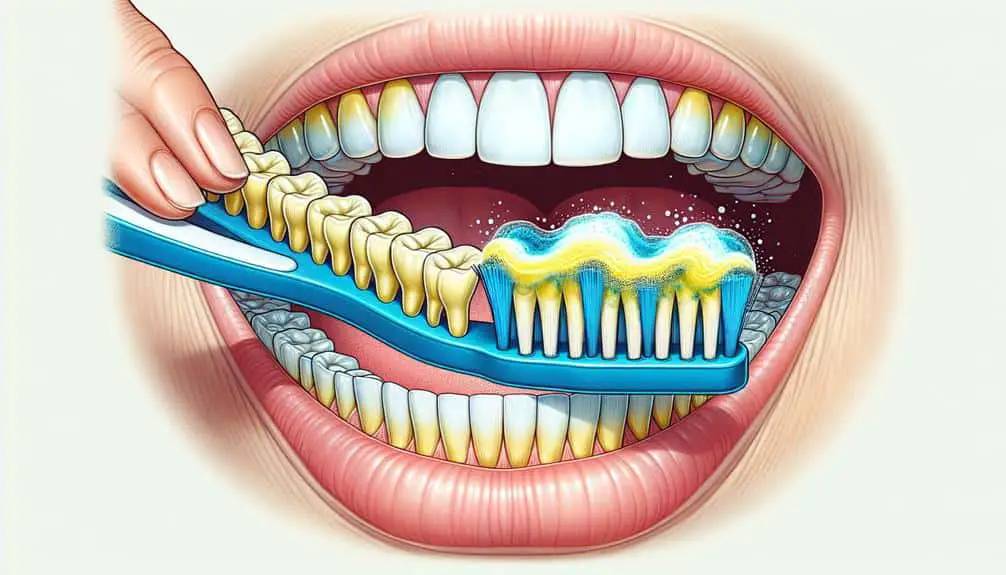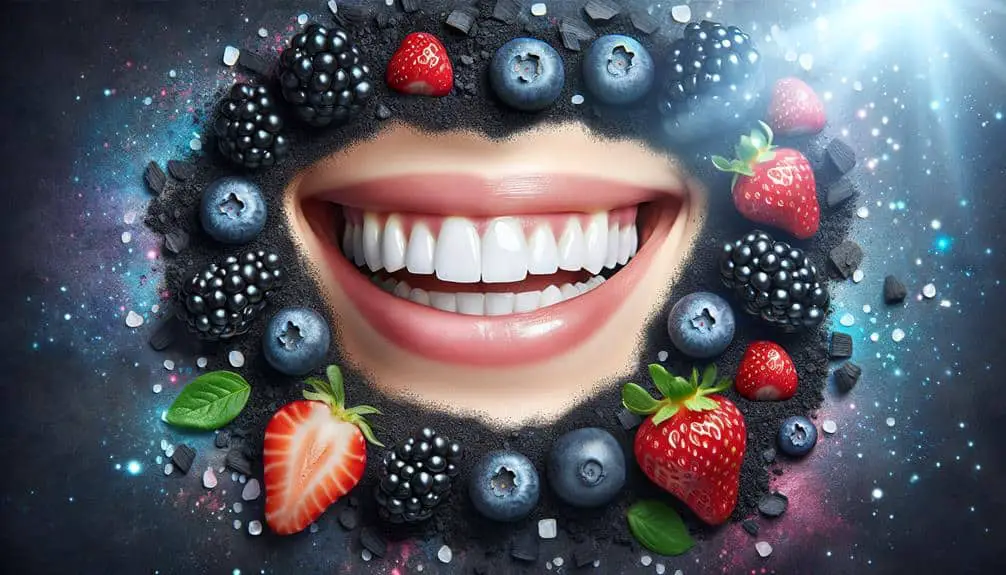You can tackle fluoride stains with these DIY methods: create a paste with baking soda, rinse with hydrogen peroxide, scrub with activated charcoal, try oil pulling, use lemon juice rinse, soak with apple cider vinegar, and try coconut oil pulling. Go natural to brighten your smile at home effectively.
Key Points
- Baking soda paste: Gently scrub stains with its mild abrasive properties.
- Hydrogen peroxide rinse: Use as a natural antiseptic and bleaching agent.
- DIY Lemon Juice Rinse: Citric acid helps lighten fluoride stains.
- Activated Charcoal Scrub: Absorbs stains, but be cautious to protect enamel.
- Consult dental professionals for personalized advice and monitoring progress.
Baking Soda Paste Method
To effectively whiten fluoride stains, consider utilizing the baking soda paste method for a natural and affordable solution. Baking soda, or sodium bicarbonate, is a versatile ingredient known for its mild abrasive properties, making it an excellent choice for gently scrubbing away surface stains on teeth. This method falls under the category of natural remedies and can be easily prepared at home.
To create the baking soda paste, simply mix a small amount of baking soda with a few drops of water to form a thick consistency. Apply this paste to your toothbrush and gently brush your teeth for about two minutes. Rinse thoroughly with water. The mild abrasive nature of baking soda helps to remove surface stains caused by fluoride while being gentle on the enamel.
Regular use of the baking soda paste method, along with proper oral hygiene practices, can contribute to gradually reducing fluoride stains and restoring the natural whiteness of your teeth. Remember, consistency is key when using home solutions like this for teeth whitening.
Hydrogen Peroxide Rinse Technique
Consider incorporating the hydrogen peroxide rinse technique as a potential method for addressing fluoride stains on your teeth. Hydrogen peroxide is a mild antiseptic and bleaching agent that can help lighten stains on the enamel. When used correctly, it can be an effective DIY solution for improving the appearance of your teeth.
To utilize this technique, mix equal parts of hydrogen peroxide and water to create a gentle mouthwash solution. Swish the mixture around in your mouth for about 30 seconds, being careful not to swallow any of it. After rinsing, make sure to thoroughly brush your teeth with a fluoride toothpaste to remove any remaining peroxide solution.
It's important to use this rinse technique in moderation, as excessive use can irritate the gums and lead to sensitivity. Limit use to a few times a week and always follow up with a fluoride mouthwash to help protect your enamel. Remember, good toothbrush techniques and mouthwash alternatives can also contribute to maintaining a healthy and bright smile.
Activated Charcoal Scrub
If you're looking to explore an alternative approach for addressing fluoride stains on your teeth, the Activated Charcoal Scrub technique may offer a natural solution worth considering. Activated charcoal has gained popularity for its ability to absorb toxins and stains, making it a potential option for whitening teeth. While charcoal toothpaste benefits are often touted for their stain-removing properties, using activated charcoal directly as a scrub can provide a more concentrated application. The charcoal face mask trend has also highlighted the potential of activated charcoal in skincare and dental hygiene.
To create an Activated Charcoal Scrub, mix a small amount of activated charcoal powder with water to form a paste. Gently brush this paste onto your teeth, focusing on areas with fluoride stains. Allow the scrub to sit for a few minutes before rinsing thoroughly. When using activated charcoal, it's important to do so sparingly to avoid damaging the enamel. Remember that while this method may show some results, it's always recommended to consult with a dental professional for personalized advice on dealing with fluoride stains.
Oil Pulling Therapy
Oil pulling therapy involves swishing oil in your mouth to promote oral health and potentially whiten teeth. This ancient practice is rooted in natural remedies and is believed to help eliminate harmful bacteria in the mouth. By swishing oil around for about 15-20 minutes, the oil supposedly binds to the bacteria and toxins in the mouth, which are then expelled when the oil is spit out.
Research on oil pulling is still limited, but some studies suggest that it can help improve oral health by reducing harmful bacteria, plaque, and gingivitis. While there's anecdotal evidence supporting its teeth-whitening effects, more scientific research is needed to confirm these claims.
Common oils used for oil pulling include coconut, sesame, and sunflower oil. It's essential to note that oil pulling shouldn't replace regular brushing and flossing but can be used as a supplementary measure to enhance oral hygiene. If you decide to try oil pulling, remember to consult with your dentist to make sure it complements your oral care routine effectively.
DIY Lemon Juice Rinse
To further enhance your teeth whitening efforts at home, a DIY Lemon Juice Rinse can be a natural and cost-effective method worth exploring. Lemon juice is known for its citrus fruit benefits, containing citric acid that may help whiten teeth. The natural acidity in lemon juice can act as a mild bleach to lighten stains on the teeth's surface.
To create a DIY Lemon Juice Rinse, simply mix fresh lemon juice with an equal amount of water. Swish this mixture around your mouth for about a minute, being careful not to let it sit on your teeth for too long as the acid could potentially erode the enamel. After rinsing with the lemon juice mixture, thoroughly brush your teeth with fluoride toothpaste to remove any remaining acid from the surface of your teeth.
While lemon juice can contribute to natural teeth whitening, it's important to use this method sparingly to avoid damaging your enamel. Consistent and excessive use of acidic substances like lemon juice could lead to enamel erosion over time.
Apple Cider Vinegar Soak
For a potential natural teeth whitening solution, consider incorporating an Apple Cider Vinegar Soak into your oral care routine. Apple cider vinegar is often lauded for its numerous health benefits, including its potential to whiten teeth due to its acetic acid content. This natural remedy has been used for centuries for various purposes, including dental care.
Vinegar benefits, particularly those of apple cider vinegar, are attributed to its antibacterial properties that can help in removing stains and killing bacteria in the mouth. To create an Apple Cider Vinegar Soak, mix one part apple cider vinegar with two parts water. Swish this solution around in your mouth for a few minutes, ensuring it reaches all areas. Then, rinse your mouth thoroughly with water to prevent the acidity from affecting your tooth enamel.
While apple cider vinegar may show some promising results in teeth whitening, it's essential to use it cautiously due to its acidic nature, which may erode the enamel with prolonged use. Incorporate this soak sparingly into your oral care routine for potential natural teeth whitening benefits.
Coconut Oil Pulling Hack
Consider integrating a coconut oil pulling hack into your oral care routine for potential teeth whitening benefits. Coconut oil has gained popularity for its oral health advantages, including possible teeth whitening effects. The lauric acid found in coconut oil has antimicrobial properties that may assist in reducing bacteria in the mouth, promoting healthier gums and fresher breath.
One of the natural teeth whitening choices, coconut oil pulling involves swishing coconut oil around in your mouth for approximately 15-20 minutes. This procedure is believed to aid in the removal of plaque and bacteria, which can lead to teeth discoloration. Nonetheless, it's important to note that while some individuals report brighter teeth after consistent use of coconut oil pulling, scientific proof of its teeth whitening effects is limited.
While coconut oil pulling has its advantages, some disadvantages include the time commitment and the necessity for consistency to observe potential results. It's always advised to consult with your dentist before integrating any new oral care practices to ensure they align with your overall dental health objectives.
Frequently Asked Questions
Can Fluoride Stains Be Permanently Removed With These DIY Methods?
Fluoride stains can be challenging to remove permanently with DIY methods. Professional options like dental bleaching may offer long-term effectiveness. Alternatives include bonding or veneers. Regular maintenance and follow-up care are essential for lasting results.
Are There Any Potential Side Effects or Risks Associated With Using These Whitening Techniques?
When considering whitening techniques for fluoride stains, it's important to be aware of potential risks. Safety concerns include tooth sensitivity, gum irritation, and enamel damage. Consult a dentist before starting any DIY methods.
How Often Should These DIY Whitening Methods Be Used to See Results?
For peak results, use DIY whitening methods consistently. Aim for applying them every other day to see improvements within a few weeks. Remember, frequent use can lead to better outcomes, but always prioritize oral health.
Are There Any Specific Toothpastes or Products That Should Be Avoided When Trying to Whiten Fluoride Stains at Home?
When trying to whiten fluoride stains at home, avoid toothpaste with harsh abrasives like charcoal or baking soda. Opt for gentle whitening toothpaste instead. DIY alternatives such as baking soda and hydrogen peroxide can be effective.
Is It Possible to Combine Multiple DIY Methods for Better Results, or Should They Be Used Individually?
When it comes to DIY whitening, best practices suggest focusing on one method at a time to gauge effectiveness before combining. For instance, start with oil pulling for a week, then introduce baking soda to see how your teeth respond.



